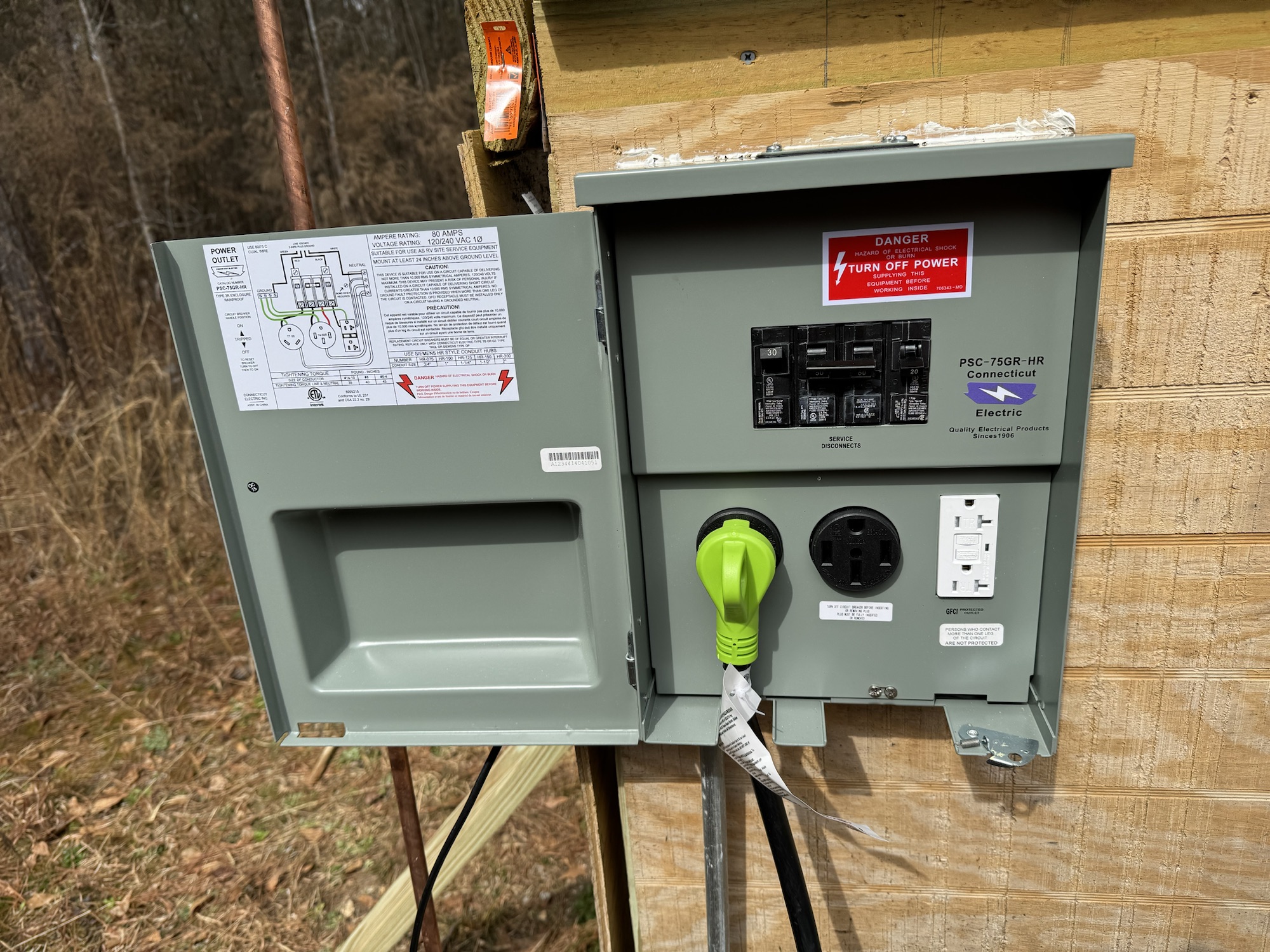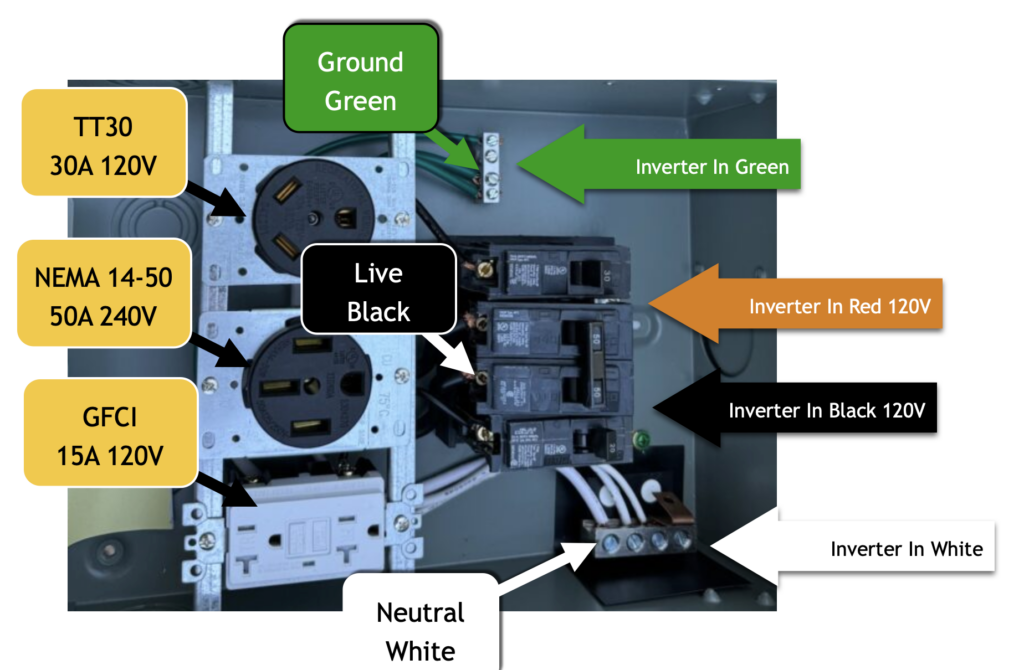In building out our solar system for Blue Skies Cabin at Rally Creek, I chose to put in a more advanced outdoor breaker box for our “RV Style” (TT30) connection. I chose a breaker box from Connecticut Power that had not only the TT30 RV type connector to go to Blue Skies, but also included a NEMA 14-50 connection for when I want to charge my EV as the system grows. Along the way I found a unit that also included two GFCI 120 Volt plugs right in the breaker box. That will make it easy to plug in our tools our other temporary AC-driven devices when outside without having to run extension cords from inside the cabin.

That’s pretty sweet.
The problem, which I quickly discovered while wiring up the box, is that it is designed for USA standard 240 Volt household electrical service to make all those outlets work at the same time.
My current installation with the Renogy 2000W inverter only provides the typical 120 Volt USA “inside the house” outputs. While great for easily plugging in any standard American 120 volt household device, it is only half of what I need to run this new box.
What Is USA Standard 240 Volt Household Electrical Service?
The power that comes into most households in America is a 240 volt 100 Amp service. When it comes into the main breaker box in your house there are 3 big wires coming in. Two of those wires are the “live” wires each pushing 120 volts into the breaker box. The third line in “neutral” — the “return power” line. Typically half the breakers in your breaker box are running on one of those live lines, the other half on the other live line.
Thus your normal outlets in the house output the 120 volt AC most of us are aware of.
Your large appliances – the stove, the dryer, and others often use an “appliance plug”. This is typically a 240 volt plug which “behind the scenes” is connected to both sides of the breaker box, with one wire connected to the left bringing in 120 volts, one on the right bringing in 120 volts, and the white neutral. These two different 120 volts sides of the panel are called “split phase” (why? we won’t go that deep here — you’re welcome). An individual side is considered a “single phase” of that split phase.
The NEMA 14-50 outlet in my breaker box is also a 240 volt “appliance outlet”. It is wired the same way.
As a safety feature, both the 120 volt and 240 volt wiring also includes a bare copper wire, or green wire, that is “ground”. This is not connected to the power grid, but is connected throughout the house and eventually to a big copper rod driven into the ground outside your house. It doesn’t typically carry any electrical load unless something goes very wrong.
3-Wire Versus 4-Wire Electrical Wires
To wire this all up you use either 3-wire or 4-wire cables.
3-Wire 120 Volts : A standard 120 volt system, like that on the Renogy 2000W Inverter, supports 3-wires. Inside the electrical cable you will see a black wire for 120 volt “live” power, a white wire for “return neutral”, and the green or copper wire for ground. This is all you need to power up the standard outlets in a house or cabin — or to power a single 30 amp TT30 RV outlet. These are on our product listing as 12/2 wires (they don’t count/list the ground wire) — which is a 12-gauge cable with a black , white, and ground wire.
4-wire 240 Volts : In a USA based 240 volt system (not to be confused with European 220v 50hz systems) — you have 4-wires. Inside you will find the same black 120 volt live power, white “return neutral”, copper/green ground wire, and a new 4th wire — the red 120 volt live power. This is used to connect 240 volt outlets like a NEMA 14-50 (or a stove appliance outlet, or dryer outlet which may use smaller amp outlets with a slightly different shape). These are on our product listing as 12/3 wires, again they don’t count the ground wire in the cable nomenclature. The 12/3 wires are 12 gauge with a black/white/red/ground wire.
Connecting The Dots… Or Wires
Why is this background information important? Because my current setup only allows me to power EITHER the 120 volt RV outlet OR the 120 volt outdoor GFCI outlets.
The Renogy 2000W Inverter has a connection where you can wire a 3-Wire AC cable — the black/white/green type. Makes sense as the inverter can ONLY output 120 volts.
That means I can only wire HALF of my outdoor breaker box as I only have 3 wires instead of 4. I’m missing that extra “red wire”, so only the LEFT half of my breaker box is wired at the moment. This provides power to the TT30 RV outlet, but the other half of the box is “dead”.

In the image of the Connecticut Power Breaker Box above, the power from the inverter is wired to the right side (top when installed) of the box. With a 120 volt inverter you will only be able to connect three wires, the Black, White, and Green. There is no place to connect the red wire on the inverter and you would normally only use a 12/2 (black/white/green cable — they don’t count the ground in AC wire nomenclature).
On the far right of the image, behind the breakers shown are two lug screws where you connect the AC input power from the inverter. One of the screws has a metal strip going to the topmost breaker (for the TT30) and the top side of the middle double breaker. The other screw has a metal strip connect the bottom breaker (for the GFCI) and the bottom side of the middle double breaker that goes to the NEMA 14-50.
If you connect the black wire only the white GFCI outlets are powered. HALF of the middle NEMA 14-50 has power, so that is useless. The top TT30 has no power.
Since I wanted to have power to the TT30 and didn’t care about the GFCI for the moment, I connected the inverter to the “red side” of the box, putting the black wire into the top input.
I also knew that someday I would want to replace my inverter with one that output 240V / 60Hz and use the 12/3 cable so I used that cable to connect the breaker box and actually wired both the top and bottom screws. On the inverter side, however, I only have black/neutral/ground — so I connected the red wire to the black on the inverter to power the TT30 side of the box. When the 240 volt inverter is put in place the inverter end will have red-to-red, black-to-black, green, white and all the outlets in the breaker box will be powered.
With all outlets powered I will have the RV outlet (TT30) for the cabin power, the two GFCI 120V outlets for outside power when needed, and the NEMA 14-50 if I ever need emergency charging for the EV. Granted the EV can eat up to 90 kWh so the 5 kWh battery bank isn’t going to help much for an EV, but it can add 20-30 miles, enough to get from the property to a local grid-powered charging station if needed.
Making 240 Volts To Power The Whole Box
My first thought was to just buy a second inverter, connect it up to the batteries and let each take power from the battery bank. While technically possible, there are some big problems with that that shows a shortcoming of the most consumer 120 volt inverters…
For 240 volt to work each 120 volt side needs to by synchronized. Thus the reason it is called “split phase”, for the AC to work as expected on a 240 volt outlet you MUST ensure each 120 volt line (the black and red wire) are working in perfect harmony. AC is a sine wave power form that oscillates on a regular basis from a positive to negative charge (60 times per second in the USA). On a properly designed 240 volt system the red wire must be at POSITIVE voltage while at the same exact instance the b lack wire must be at NEGATIVE voltage. It must be timed perfectly or shit breaks.
Most standard low-cost inverters operate in standalone mode. You have NO CONTROL over when it pushes a positive charge or a negative. Assuming the inverters start at exactly the same time and you wire one to the “red line” and the other to the “black line” and these inverters works EXACTLY the same way (not likely) you would end up with both red and black pushing a positive charge at the same time. No bueno.
However, they do make inverters that have a communication port that allows two inverters to talk to each other. These more costly inverters can then be setup as described above, but they continually communicate — “hey I”m making positive things over here — you do the opposite”. Thus made to allow you to connect your two inverters , one to each phase of the split-phase 240v breaker box.
The other option — you can purchase something like the VIctron MulitPlus-II Inverter (and charger) which is designed “out of the box” with a 4-wire connection right on the back. It has the connection for the black/white/green AND red 4-wire system. You get a proper USA style 240 volt 60 hertz output to connect a higher end break box like the one I have. If you don’t need that, you can still connect just the black/white/green wires and get basic 120 volt service.
The downside to the Victron Multiphase II — there is no direct “just plug 120 volt shit in” directly on the back of the inverter like you have with the Renogy 2000W option. Since I now have all my outlets and cabin wired, that is not a deal breaker for me. A few months ago it was as we connected the Blue Skies Cabin directly via a 120V extension cord plugged directly into the inverter.
